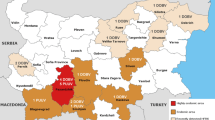Abstract
Dobrava (DOBV) and Puumala (PUUV) viruses are endemic throughout the Balkans and cause haemorrhagic fever with renal syndrome (HFRS). The aim of this study was to assess the impact of two different hantaviruses on renal function in HFRS patients during the acute stage of illness. We also aimed to assess the DOBV and PUUV distribution between symptomatic HFRS patients and asymptomatic hantavirus antibody-positive subjects. The study included 264 symptomatic HFRS patients and 63 asymptomatic hantavirus antibody-positive healthy subjects. In our study, 131 (49.6%) HFRS patients were regarded as PUUV- and 69 (26.1%) as DOBV-infected patients, while in 64 (24.2%) of HFRS patients that showed all clinical and biochemical signs of HFRS, the causal hantavirus could not be determined with commercially available tests. DOBV-infected patients were associated with more requirements for haemodialysis treatment, lower diuresis and higher serum creatinine and urea values compared to PUUV-infected patients. PUUV was significantly predominant in asymptomatic hantavirus antibody-positive subjects (69.8%) compared to HFRS patients. DOBV was present in 17.5% of asymptomatic subjects and, interestingly, the preferential hantavirus serotype could not be determined in 12.7% of the asymptomatic antibody-positive subjects.
Similar content being viewed by others
References
Heyman P, Vaheri A; ENIVD Members (2008) Situation of hantavirus infections and haemorrhagic fever with renal syndrome in European countries as of December 2006. Euro Surveill 13(28). Available online at: http://www.eurosurveillance.org/ViewArticle.aspx?ArticleId=18925
Bi Z, Formenty PB, Roth CE (2008) Hantavirus Infection: a review and global update. J Infect Dev Ctries 2(1):3–23
Lednicky JA (2003) Hantaviruses. A short review. Arch Pathol Lab Med 127:30–35
Vapalahti O, Mustonen J, Lundkvist A et al (2003) Hantavirus infections in Europe. Lancet Infect Dis 3:653–752
Gaon J, Karlovac M, Gresikova M et al (1968) Epidemiological features of hemorrhagic fever. Folia Med Sar 3:23–43
Hukić M, Muzaferović S, Tulumović D et al (2003) Puumala and Dobrava viruses in the northeastern and central regions of Bosnia. Acta Med Croatica 57:373–380
Gligic A, Stojanovic R, Obradovic M et al (1992) Hemorrhagic fever with renal syndrome in Yugoslavia: epidemiologic and epizootiologic features of a nationwide outbreak in 1989. Eur J Epidemiol 8:816–825
Markotić A, LeDuc JW, Hlaca D et al (1996) Hantaviruses are likely threat to NATO forces in Bosnia and Herzegovina and Croatia. Nat Med 2:269–270
Hukić M, Kurt A, Torstensson S et al (1996) Haemorrhagic fever with renal syndrome in north-east Bosnia. Lancet 347:56–57
Lundkvist A, Hukić M, Hörling J et al (1997) Puumala and Dobrava viruses cause hemorrhagic fever with renal syndrome in Bosnia-Herzegovina: evidence of highly cross-neutralizing antibody responses in early patient sera. J Med Virol 53:51–59
Hukić M, Tulumović D, Calkić L (2005) The renal failure and capillary leak during the acute stage of (Dobrava) DOB and PUU (Puumala) infection. Med Arh 59(4):227–230
Tulumovic D, Imamovic G, Mesic E et al (2009) Comparison of the effects of Puumala and Dobrava viruses on early and long-term renal outcomes in patients with haemorrhagic fever with renal syndrome. Nephrology 15(3):340–343
Cebalo L, Dusek T, Kuzman I et al (2003) Grading the severity of disease in patients with Puumala or Dobrava virus infections from 1995 to 2000 in Croatia. Acta Med Croatica 57(5):355–359
Puljiz I, Kuzman I, Turcinov D et al (2003) Clinical and epidemiologic characteristics of hemorrhagic fever with renal syndrome in patients treated at the Dr. Fran Mihaljević Clinic for Infectious Diseases in Zagreb. Acta Med Croatica 57(5):347–353
Pal E, Strle F, Avsic-Zupanc T (2005) Hemorrhagic fever with renal syndrome in the Pomurje region of Slovenia—an 18-year survey. Wien Klin Wochenschr 117(11–12):398–405
Medved MM, Markotić A, Cebalo L et al (2002) Haemorrhagic fever with renal syndrome in Croatia. Lancet 360(9330):415–416
Markotić A, Nichol ST, Kuzman I et al (2002) Characteristics of Puumala and Dobrava infections in Croatia. J Med Virol 66(4):542–551
Kuzman I (2003) Clinical picture of hemorrhagic fever with renal syndrome in Croatia. Acta Med Croatica 57(5):393–397
Author information
Authors and Affiliations
Corresponding author
Rights and permissions
About this article
Cite this article
Hukić, M., Valjevac, A., Tulumovic, D. et al. Pathogenicity and virulence of the present hantaviruses in Bosnia and Herzegovina: the impact on renal function. Eur J Clin Microbiol Infect Dis 30, 381–385 (2011). https://doi.org/10.1007/s10096-010-1097-6
Received:
Accepted:
Published:
Issue Date:
DOI: https://doi.org/10.1007/s10096-010-1097-6




